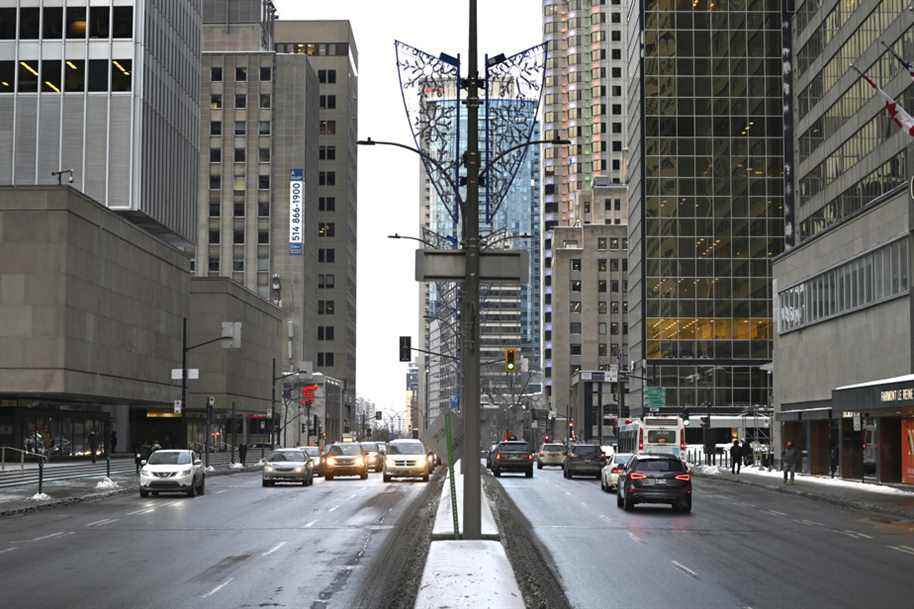The promoters of the province’s two light rail projects – the REM de l’Est and the tramway de Québec – have unveiled video simulations a few days apart, images that give an idea of urban integration, but leave also several outstanding questions.
Posted at 5:00 a.m.
In Montreal, CDPQ Infra wants to build the second phase of the Metropolitan Express Network (REM) largely on aerial structures, particularly downtown. According to the expert in transport planning at the University of Montreal Pierre Barrieau, the new images of this 32 kilometer project “leave several questions”, even if the promoters seem “to have pushed the exercise as far as they can. “.
The simulation shows a few hundred meters of the route, in the business district, where the train would come out of the ground to migrate on a white concrete structure. These images do not necessarily give an overall idea of what the network might look like, believes Mr. Barrieau. For example, there is no graffiti or homeless people, which abound in the area.
“Not very realistic”
The video prepared by the architectural firm Lemay nevertheless allows a good view of the new configuration of René-Lévesque Boulevard, which would go from eight to four traffic lanes. It also presents several facilities, such as a bike path, public places and greenery, which should be added by the City of Montreal upstream of the 10 billion dollar project.
These images are “a bit of window dressing,” says Shin Koseki, holder of the UNESCO Chair in Urban Landscape at the University of Montreal.
Propose spaces that have not been considered by a design team under one government or another, it is not very realistic.
Shin Koseki, holder of the UNESCO Chair in Urban Landscape at the University of Montreal
Florence Junca-Adenot, professor in the urban and tourism studies department at UQAM, goes further. She believes the images are downright “dishonest”. “It’s wrong to present it like that. The representations are not even to scale. We give the impression that the height is a few meters, while they themselves say that it will be seven stories high, ”she says.
“Undeniable” efforts
Sylvain Gariépy, president of the Ordre des urbanistes du Québec, acknowledges that “undeniable” efforts have been made to make the structure more delicate than that of the first phase of the REM. However, he notices a “wall” effect in the 300-meter transition zone between the underground and aerial modes, and wonders about the realism of the digitally added plants in the shadow zone that will be created by the structure.
The town planner would also have liked to see a larger simulation, which would have included the east and northeast sections of the REM de l’Est. “We very little address the issue outside the city center, and that concerns me. »
Joined by The Press, Jean-François Arcand, architect and senior partner of the Lemay firm, which produced the video, defends the realism of the simulation. He claims that it “uses video game technology that uses artificial intelligence”.
“This allows the public to have a realistic view of the proposed concepts and to understand how their creation fits into the surrounding environment,” he said. All of the major projects we work on today benefit from this approach inspired by industry best practices. »
“More coherent” in Quebec
In the case of the Quebec tramway – which also presented images of its remodeled project last Monday – the experts consulted by The Press speak of a project a priori more consequent.

PHOTO PATRICE LAROCHE, LE SOLEIL ARCHIVES
Preparatory work for the tramway project on chemin des Quatre-Bourgeois, in Quebec City, on March 8
“The discourse is much more coherent, especially since for the tramway, the City guarantees the development. It’s a more realistic intention,” says Shin Koseki. He also says he perceives “a greater communication effort” around the project, despite the many setbacks he too has suffered in recent months.
Same story with Florence Junca-Adenot. “A tramway is more easily integrated into the central streets of a city centre. It’s slower, it shares the roadway, so it’s less intrusive. It’s the technology that makes the big difference, beyond the visual renderings,” she adds, recalling that “around the world, trams fit in rather well in city centers.”
Pierre Barrieau also notes that the work seems much more mature in the capital at this stage.
We can almost talk about plans for quotes. It is therefore much clearer to allow us to position ourselves than in Montreal, where it seems too early to give a firm judgment.
Pierre Barrieau, transport planning expert at the University of Montreal
Sylvain Gariépy believes that the demonstration made by Quebec is “more complete”. “We are shown the network in all possible climatic conditions, as well as images of the interior and exterior of the tramway. »
The tramway, piloted by the City of Quebec, got the green light from the Legault government earlier this week. The 19.3 km network (including 1.2 km underground) will be financed by Quebec, Ottawa and the City, and its bill is estimated at 3.96 billion.
In Montreal, Quebec has mandated CDPQ Infra, a subsidiary of the Caisse de dépôt, to develop the REM de l’Est in the form of a “public-public partnership”. The planned environmental studies have been postponed from spring to the end of 2022.


